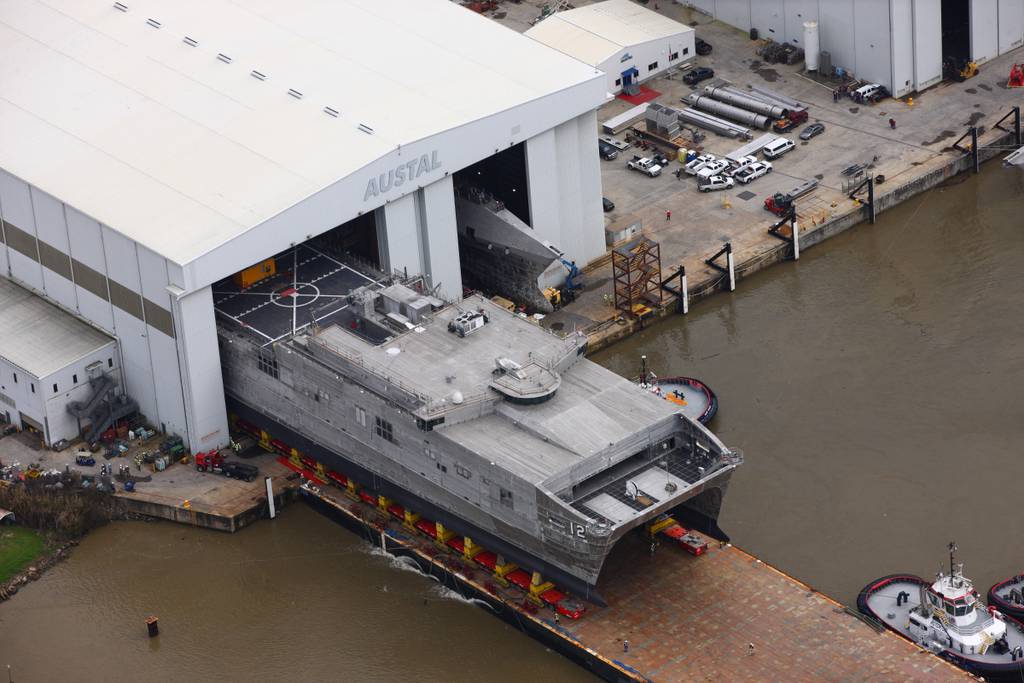MOBILE, Ala. — Blue and yellow machines whirred, autonomously welding the steel that Austal’s Alabama shipyard will need to build nuclear submarine components as the company moves away from aluminum vessels.
Two massive yellow cranes moved horizontally across the ceiling above, illuminated by LED lights that grew dimmer farther down the 117,00-square-foot facility, delineating the point where a wall was knocked down one year ago to expand the building for the steel line.
Aluminum modules for the very last littoral combat ship under production stand among the steel sheets, which the Australia-based company will need for its new contracts: offshore patrol cutters for the U.S. Coast Guard, towing and salvage chips for the U.S. Navy, and key components for Columbia- and Virginia-class submarines.
Austal is banking on nuclear-powered submarine work as a major driver of growth in the coming years, to the point where the company will need to increase its workforce by a third. That would involve 1,000 additional hires to staff a new facility at the shipyard by the end of next year.
The planned facility, which is currently under design, is a physical manifestation of recent U.S. government investments aimed at expanding submarine production capacity.
“We’re putting a new building in that’s going to be dedicated fully to submarine work,” Larry Ryder, Austal’s vice president for business development and external affairs, told Defense News in an interview on Thursday. “It’s going to be about 1,000 jobs of output, supporting the submarine-industrial base.”
Broken down further, the company expects to hire an additional 200 employees at its Alabama shipyard for submarine work this year, with another 800 to join them once the facility is up and running next year.
The shipyard received a $50 million Defense Production Act grant to construct the new submarine module facility, which Austal matched with another $50 million from its own coffers. The facility will take about a year to construct.
Industrial base capacity has come under close scrutiny amid the recent trilateral AUKUS agreement, in which the U.S. and U.K. will help Australia acquire its own fleet of nuclear submarines. The U.S. Navy ultimately aims to build one Columbia-class and two Virginia-class submarines per year, and AUKUS mandates the U.S. sell Australia five of the latter class in the 2030s as an interim capability.
General Dynamics Electric Boat’s shipyard in Connecticut, which produces both submarine classes, ultimately elected to subcontract the production of multiple modules for these vessels to Austal, hoping that outsourcing to another shipyard will accelerate production timelines.
“We had capacity, we needed work, and the Navy knows we do quality work on time,” Ryder said. “Took a little while to get the relationship with Electric Boat. Like any prime, we’re all reluctant to give away work and trust somebody else with the quality. But we’ve got a real good relationship with them going now.”
Once Austal completes the command-and-control systems modules and the electronic deck modules for the submarines, it will ship them by barge to Electric Boat for installation.
The submarine work marks a significant turn of fortune for Austal after it lost a $5.5 billion Navy contract in 2020 to build a new class of frigates as the Littoral Combat Ship program neared its conclusion.
“It was about a year and a half ago we were looking at laying off 1,000 folks,” Ryder said. “Now we’re trying to hire 1,000 folks.”
Bryant Harris is the Congress reporter for Defense News. He has covered U.S. foreign policy, national security, international affairs and politics in Washington since 2014. He has also written for Foreign Policy, Al-Monitor, Al Jazeera English and IPS News.








